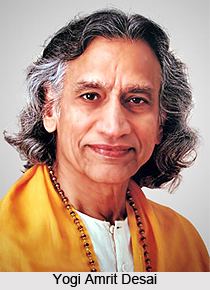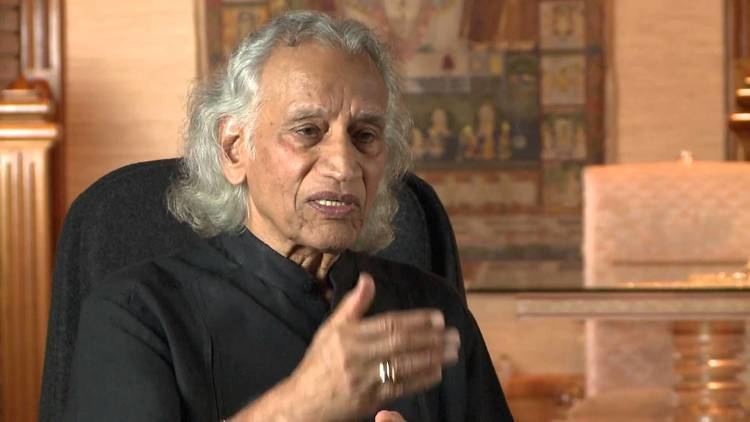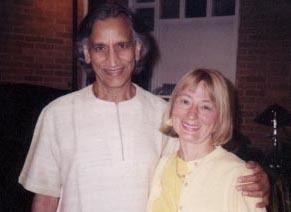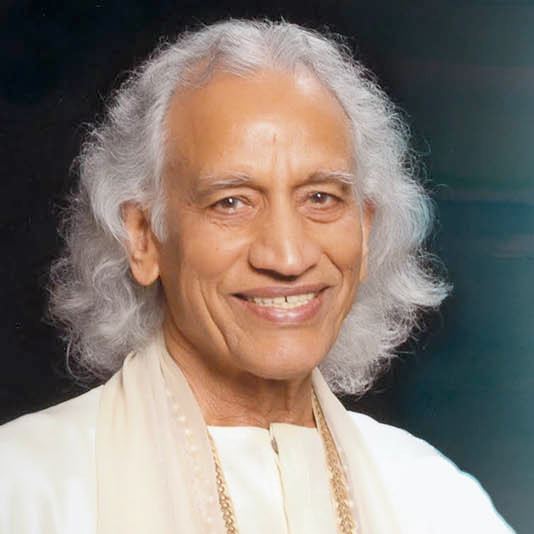Name Amrit Desai | ||
 | ||
Yogi amrit desai the yoga of relationships
Yogi Amrit Desai is one of the earliest pioneers of yoga in the West, and is one of the few remaining living yoga masters who originally brought over the authentic teachings of yoga in the early 1960s. He is the creator of two brands of yoga, Kripalu Yoga and I AM Yoga, and is the founder of five yoga and health centers in the US. His yoga training programs have reached more than 40 countries worldwide and over 8,000 teachers have been certified.
Contents
- Yogi amrit desai the yoga of relationships
- Yoga nidra led by yogi amrit desai
- Early life
- Art career
- Yoga pioneer
- A Shaktipat lineage
- Controversy
- Post Kripalu years and the Amrit Yoga Institute
- Humanitarian work
- Awards
- Publications and media
- References

Homegrown Gurus (2013) states: "Although Desai has not received scholarly attention, he has arguably been one of the most influential and sought-after figures in the development of Hatha Yoga in America over the last 40 years."

Yoga nidra led by yogi amrit desai
Early life

Born on October 16, 1932, Amrit Desai is the second son of Chimanlal and Buribhen Desai. A member of the merchant class, Chimanlal supported his family by bartering goods in his storefront, literally a veranda in front of their home in the tiny village of Pratappura in the western state of Gujarat, India. Later, when Amrit was ten, the family moved to Halol. Although Amrit preferred sports over study, his heart ached for spiritual growth, even at an early age. But he was not attracted to the rituals in the Vaishnav temple to which his parents belonged. He wanted to learn from a living master rather than from rituals and dogma. At age 15, he got his wish when he met his guru, Swami Kripalvananda (Bapuji), a wandering sadhu who was offering free talks on the deeper meaning of the Bhagavad Gita in Halol. Bapuji's guru, Dadaji, is said to be Lord Lakulish, the 28th incarnation of Shiva.

Young Amrit taught himself the practice of yoga asana (postures) from a chart he had found tacked to the wall of the local gym. Such was his enthusiasm that he started teaching others outside the goshala (cow-house) where his guru lived. After the swami observed him teaching one day, he offered him a rare demonstration of his private sadhana. During the fifteen minutes that Amrit was permitted to observe, the swami went into a trance-like state and began to perform movements unlike anything he had seen on the asana charts. Amrit recalls: “The pranic energy became so strong his body was hurled across the room with tremendous force. As I watched in awe, he was dancing, weaving in and out of complicated asanas.”
After a brief period studying engineering and training with the Indian Air Force in Madras, Amrit returned to Halol and took a job teaching art at the local high school. He married his betrothed, Urmila Shah, in January 1955. The couple moved to Ahmedabad a year later where Amrit earned his art diploma over the next four years. Their first son, Pragnesh, was born in 1959. The couple had two more children, Malay (1962) and Kamini (1968). On a teacher’s salary of $30 a month, Amrit supported his wife and son, and even sent some money to his parents but, little by little, was able to collect twelve hundred dollars to fulfill his dream of going to America. In February 1960, he came to the US to study at the Philadelphia College of Art with only enough money in his pocket to cover his first semester’s tuition and rent. After a year and a half of working around the clock, teaching fashion design classes and yoga on the weekends, and washing dishes at the college cafeteria (that secured him a full meal every day), he was able to save enough money to bring his wife and infant son to the US.
Art career
Amrit Desai's creative life had started early when he made clay figures of animals as his mother washed clothes by the river bank. As a teenager, he sketched scenes of his village life and got his first job as a poster designer for a movie theater.
Graduating in 1964 with a degree in fine arts and design from the Philadelphia College of Art, he took a job with a textile firm. During this time, he also began to see success with his unique style of watercolor paintings, earning awards at a number of art shows, including a show at the prestigious Philadelphia Museum of Art. Experimenting with unusual tools, he created distinct textures and patterns with razor blades and eye-droppers. Desai's talents were not limited to painting - while still an art student, he played the flute in a "Music of India" concert at the Commercial Museum (Philadelphia Trade and Convention Center) in 1961.
His short but prolific professional career as an artist spanned only four years from 1962 to 1966. Desai abruptly abandoned the promise of his artistic pursuits to dedicate his life to the inner journey of yoga.
Yoga pioneer
Desai had started teaching yoga in the early 1960s in the Philadelphia area while still an art student. 1966 marked a turning point when, during his first visit back to India since coming to the US, Swami Kripalvananda gave him initiation and further instruction in kundalini yoga. Returning to the US, with his guru's blessing and the support of his family, he left his job with the textile firm to form The Yoga Society of Pennsylvania and dedicate himself full-time to teaching yoga. In 1970, he had a Kundalini awakening experience in which his body automatically moved through a series of flowing yoga postures without his direction. It was the movement of his body that directed his attention inward, and expanded his consciousness into the stillness and ecstasy of deep meditation. This experience revealed to him that Patanjali’s Yoga Sutras are a manual for the practice of Ashtanga Yoga rather than mere philosophy. Out of this experience Desai created a form of hatha yoga called Kripalu Yoga, named in honor of his guru. His Meditation in Motion approach is based on the practical application of Patanjali's Ashtanga Yoga in daily life. The unique system he developed combines two traditional paths of yoga: the rigorous discipline of Ashtanga yoga with the path of initiation and surrender that is Kundalini yoga. In this system, the student begins with the practice of willful discipline and gradually moves on to the more advanced practice of surrender to prana.
To date, Desai is the founder of five yoga and health centers in the US, and co-founder of a university of Ayurvedic sciences.
A Shaktipat lineage
Yogi Desai was initiated into the secrets of Shaivite kundalini yoga by his guru, Swami Kripalu (Kripalvananda), a master of tantric sadhana. There are numerous documented accounts of energetic transmission or shaktipat experienced in his presence.
Many have reported having experiences of infinity and timelessness, ineffable joy and happiness, lights and colors, energy surges running up the spine, prana kriyas (spontaneous jerking motions in the body), and other such phenomenon. Some have even found themselves in spontaneous yoga postures in configurations that would otherwise be physically impossible for them. The ability to transmit Shakti in this manner is considered a rare siddhi (yogic power) and indicative of a yoga master of high attainment. Shaktipat received in this manner sweeps out the latent samskaras or karmic memories lodged in the mental, physical, and emotional bodies, accelerating the recipient’s path towards the goal of ultimate unity, which is the literal meaning of yoga.
In “Kundalini Evolution and Enlightenment,” D.R. Butler describes a meditation led by Yogi Desai at a seminar with about 200 attendees at the 1973 ICSA Yoga Convocation. Yogi Desai was an unannounced guest at the week-long retreat.
“Clad in a flowing white robe and sitting before us, Amrit easily assumed the lotus posture, his body perfectly poised. He led us into a meditation and the first thing I noticed was a wave of euphoria permeating my body. Suddenly surges of energy like electrical charges streaked up my spine. These gradually evolved into a steady current of hot energy flowing from my tip of my spine to the top of my head... Brilliant colors stirred inside my head. I thought I would burst with happiness. Nothing had ever felt so good... In a few moments the place was a madhouse. People were crying hysterically, laughing uncontrollably, gasping for breath, even rolling on the floor. Apparently everyone was experiencing some manifestation of the same energy I was feeling... My feeling of euphoria continued for several hours and I knew I would never be quite the same again.”
Dr David Frawley has stated:
“Yogi Desai revived the ancient teachings of the millennial old Shaivite Yoga, rooted in the Lakulish tradition from Kayavarohan in Gujarat, one of the greatest centers of India’s older Yoga practices… Yogi Desai has demonstrated a Prana Siddhi in which he can allow the Universal Prana to move not only through his mind and body but also through his environment and into the audience around him, awakening their own inner prana and spiritual intelligence.” (Personal letter to Yogi Amrit Desai on the occasion of his 60th birthday).
In the afterward to Ancient Wisdom, Modern Master, Mickey Singer describes a meeting with Desai during which his heart chakra was “permanently opened” by “the simple touch of Amrit’s hand.”
Controversy
The Kripalu Center for Yoga and Health was an Ashram. One of the spiritual practices that the single residents were expected to practice was celibacy (brahmacharya). Although sex within marriage was condoned at the ashram, after his third child was born in 1968, Desai declared that he would now practice celibacy too. So important was this practice of celibacy that meetings were held and residents were asked to divulge anyone they thought might have violated that sacred practice. In 1994, it was revealed and admitted that Desai had inappropriate sexual contact with three female resident disciples and was asked to resign his salaried position as Spiritual Director.
In an open letter to the Kripalu community, Desai stated, "More than anything I want Kripalu to remain a spiritual home for many. I want you to know that we came to this decision together… I deeply regret any suffering I have caused to the people directly involved and to the entire Kripalu family."
Post-Kripalu years and the Amrit Yoga Institute
When Mickey Singer, a long-time supporter and host of Desai's seminars, heard that Desai had left the Kripalu community, he invited him and his wife to spend some quiet time living with the Temple of the Universe community in Alachua, Florida. The Desais arrived in December 1994 and stayed on the property for the better part of three years.
Desai resumed teaching in 1996 at the original Kripalu Ashram in Sumneytown, PA. After a couple of years, mostly in PA, the Desai family relocated to Salt Springs, Florida in 2002, where Yogi Desai currently teaches at the Amrit Yoga Institute, a beautiful lakeside retreat on the banks of Lake Kerr in the Ocala National Forest. Amrit Yoga Institute is an ashram where the guru-disciple relationship continues to flourish and residents enjoy the benefits of a traditional yogic lifestyle. Programs of varying length are offered for yoga teacher training, ayurveda, and recovery.
Kripalu, while no longer an ashram, continues to operate and is presently one of the largest yoga and health centers in North America, offering a wide range of programs and professional trainings in health, spirituality, yoga, and more.
Humanitarian work
Paul Harris Fellow – In 2011, Yogi Amrit Desai received this award from the Rotary Foundation of Rotary International, in Naples, Florida, "in appreciation of tangible and significant assistance given for the furtherance of better understanding and friendly relations among peoples of the world."
Bhuriben Trust – The Yug Prabha newspaper, Halol, India stated in a 2007 article, “Yogishri Amrit Desai was honored in his home town of Halol for his humanitarian works known to offer scholarships to the poor and approximately 5,000 women are helped financially through the Bhuriben Trust he established… Helpless and poor patients receive free medicines and medical treatment… [H]e has financed the building of the new children’s school in Halol.”
Awards
Publications and media
Books by Yogi Amrit Desai:
Audio and video releases of devotional chanting and yoga instruction include Ecstatic Chanting Vol I and II, and Integrative Amrit Method Yoga Level I and II.
